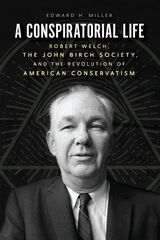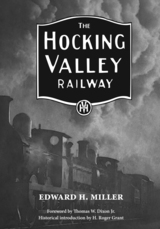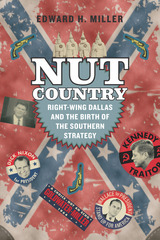4 books about Miller, Edward H.

The Born in the Spring
A Collection of Spring Wildflowers
June Carver Roberts
Ohio University Press, 2024
A must for flower and art lovers, Born in the Spring is a unique collection of line drawings and magnificent watercolors of spring wildflowers. All of the drawings and paintings were done from living plants, in minute detail, with complete botanical accuracy. There are over 90 illustrations, 46 of which are in full color. The text accompanying each plate enables the reader to easily locate the flower in its natural setting. The text also includes the origins of the common and botanical names, and bits of history and lore connected with the flowers. Some are hardy aliens that have come from all over the world, while others are fragile natives described by the earliest settlers; some are now becoming rare.
[more]

A Conspiratorial Life
Robert Welch, the John Birch Society, and the Revolution of American Conservatism
Edward H. Miller
University of Chicago Press, 2021
The first full-scale biography of Robert Welch, who founded the John Birch Society and planted some of modern conservatism’s most insidious seeds.
Though you may not know his name, Robert Welch (1899-1985)—founder of the John Birch Society—is easily one of the most significant architects of our current political moment. In A Conspiratorial Life, the first full-scale biography of Welch, Edward H. Miller delves deep into the life of an overlooked figure whose ideas nevertheless reshaped the American right.
A child prodigy who entered college at age 12, Welch became an unlikely candy magnate, founding the company that created Sugar Daddies, Junior Mints, and other famed confections. In 1958, he funneled his wealth into establishing the organization that would define his legacy and change the face of American politics: the John Birch Society. Though the group’s paranoiac right-wing nativism was dismissed by conservative thinkers like William F. Buckley, its ideas gradually moved from the far-right fringe into the mainstream. By exploring the development of Welch’s political worldview, A Conspiratorial Life shows how the John Birch Society’s rabid libertarianism—and its highly effective grassroots networking—became a profound, yet often ignored or derided influence on the modern Republican Party. Miller convincingly connects the accusatory conservatism of the midcentury John Birch Society to the inflammatory rhetoric of the Tea Party, the Trump administration, Q, and more. As this book makes clear, whether or not you know his name or what he accomplished, it’s hard to deny that we’re living in Robert Welch’s America.
Though you may not know his name, Robert Welch (1899-1985)—founder of the John Birch Society—is easily one of the most significant architects of our current political moment. In A Conspiratorial Life, the first full-scale biography of Welch, Edward H. Miller delves deep into the life of an overlooked figure whose ideas nevertheless reshaped the American right.
A child prodigy who entered college at age 12, Welch became an unlikely candy magnate, founding the company that created Sugar Daddies, Junior Mints, and other famed confections. In 1958, he funneled his wealth into establishing the organization that would define his legacy and change the face of American politics: the John Birch Society. Though the group’s paranoiac right-wing nativism was dismissed by conservative thinkers like William F. Buckley, its ideas gradually moved from the far-right fringe into the mainstream. By exploring the development of Welch’s political worldview, A Conspiratorial Life shows how the John Birch Society’s rabid libertarianism—and its highly effective grassroots networking—became a profound, yet often ignored or derided influence on the modern Republican Party. Miller convincingly connects the accusatory conservatism of the midcentury John Birch Society to the inflammatory rhetoric of the Tea Party, the Trump administration, Q, and more. As this book makes clear, whether or not you know his name or what he accomplished, it’s hard to deny that we’re living in Robert Welch’s America.
[more]

The Hocking Valley Railway
Edward H. Miller
Ohio University Press, 2024
The Hocking Valley Railway was once Ohio’s longest intrastate rail line, filled with a seemingly endless string of coal trains. Although coal was the main business, the railroad also carried iron and salt. Despite the fact that the Hocking Valley was such a large railroad, with a huge economic and social impact, very little is known about it. The Hocking Valley Railway traces the journey of a company that began in 1867 as the Columbus & Hocking Valley, built to haul coal from Athens to Columbus. Extensions of the line and consolidation of several branches ultimately created the Columbus, Hocking Valley & Toledo. This was a 345-mile railway, extending from the Lake Erie port of Toledo through Columbus and on to the Ohio River port of Pomeroy. The history of the Hocking Valley, like that of other railroads, is one of boom times and depression. By the 1920s, the Hocking coalfields were largely depleted, and the mass of track south of Columbus became a backwater, while the Toledo Division boomed. The corporate name has been gone for more than three-quarters of a century, but the Hocking Valley lives on as an integral part of railroad successor CSX. The Hocking Valley Railway, complete with 150 photographs and illustrations, also documents a historic transformation in midwestern transportation from slow canalboats to fast passenger trains. Historians and railroad enthusiasts will find much to savor in the story of this ever-changing company and the managers who ran it.
[more]

Nut Country
Right-Wing Dallas and the Birth of the Southern Strategy
Edward H. Miller
University of Chicago Press, 2015
On the morning of November 22, 1963, President Kennedy told Jackie as they started for Dallas, “We’re heading into nut country today.” That day’s events ultimately obscured and revealed just how right he was: Oswald was a lone gunman, but the city that surrounded him was full of people who hated Kennedy and everything he stood for, led by a powerful group of ultraconservatives who would eventually remake the Republican party in their own image.
In Nut Country, Edward H. Miller tells the story of that transformation, showing how a group of influential far-right businessmen, religious leaders, and political operatives developed a potent mix of hardline anticommunism, biblical literalism, and racism to generate a violent populism—and widespread power. Though those figures were seen as extreme in Texas and elsewhere, mainstream Republicans nonetheless found themselves forced to make alliances, or tack to the right on topics like segregation. As racial resentment came to fuel the national Republican party’s divisive but effective “Southern Strategy,” the power of the extreme conservatives rooted in Texas only grew.
Drawing direct lines from Dallas to DC, Miller's captivating history offers a fresh understanding of the rise of the new Republican Party and the apocalyptic language, conspiracy theories, and ideological rigidity that remain potent features of our politics today.
[more]
READERS
Browse our collection.
PUBLISHERS
See BiblioVault's publisher services.
STUDENT SERVICES
Files for college accessibility offices.
UChicago Accessibility Resources
home | accessibility | search | about | contact us
BiblioVault ® 2001 - 2024
The University of Chicago Press









